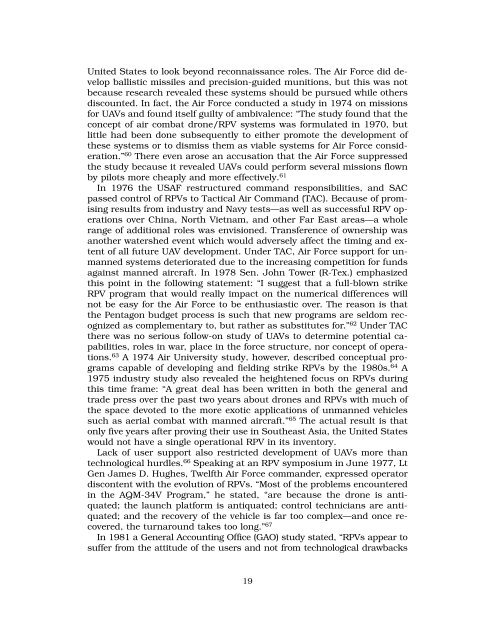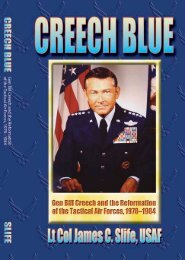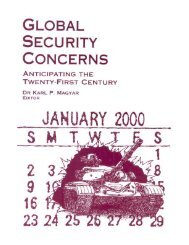tions. One specially modified drone was reported to have drawn 10 or 11SAMs be<strong>for</strong>e being shot down. 53 The top per<strong>for</strong>ming drone flew an incredible68 sorties, averaging twelve targets per mission. 54 In the latter part ofthe war, survival rates of UAVs exceeded 90 percent. While difficult tomake a direct comparison, there is a definite contrast with manned aircraftstatistics: “In that same war America lost more than 2,500 mannedaircraft, about 5,000 of her airmen were killed, and nearly 90 percent ofall US servicemen taken prisoner were pilots and crewmen.” 55At the same time that the United States was attempting to understandand appreciate unmanned aircraft, the Israeli Defense Force effectivelyused UAVs over battlefields in the October 1973 Yom Kippur War andagain in the 1982 Bekáa Valley air battle. The Israelis innovatively employedUMA to “fingerprint” SAM radars, simulate full-size decoy attackaircraft, per<strong>for</strong>m electronic countermeasures, and conduct real-time intelligencegathering. 56 Most noteworthy was their effective use as decoys.By sending in UAVs to spearhead an attack, virtually all enemy SAMs wereexpended at once. This revealed SAM locations, and Israeli suppression ofenemy air defenses sorties were thus able to follow and knock out missiledefenses while the enemy was reloading. It was reported that one RPVsafely returned <strong>for</strong> recovery after surviving attacks by 32 SAMs.Despite the successful US missions conducted over Southeast Asia,there were difficulties associated with UAVs. Initially, novice operatorsand maintenance crews were only able to generate three to four sorties perairframe. By the end of the war, they managed to increase this number to25. During this learning experience, any UMA loss still caused repercussions.This was because military leaders treated it in the same manner asthe loss of a manned aircraft. In 1979 US Air Force (USAF) Col William E.Krebs authored a paper titled, “Did We Err in the Development of RPVs(RPVs)?” One of his findings was that during the Vietnam War, “an RPVloss was treated like an aircraft loss—fleets were grounded, boards<strong>for</strong>med, data generated, commanders fired, and worst of all, prejudiceagainst RPVs vis-à-vis manned aircraft developed.” 57The time frame of US involvement in Southeast Asia was a period of extensiveUAV research and testing. The evolutionary program <strong>for</strong> TeledyneRyan’s Firebee consisted of 26 configurations, 903 airframes, and 1,100major modifications. 58 RPV test demonstrations extended well beyond reconnaissanceinto attack roles; however, it was the Navy, not the AirForce, leading this ef<strong>for</strong>t. According to Jane’s <strong>Remotely</strong> <strong>Piloted</strong> <strong>Vehicles</strong>:“The US Navy has even evaluated RPV interceptors in simulated air combatagainst a McDonnell Douglas F-4 Phantom II flown by a highly experiencedaircrew. The results were thought-provoking. All the Sparrow andSidewinder missiles launched from the Phantom missed the RPV, but thelatter maneuvered itself several times into positions from which it couldhave brought down the Phantom had it been armed.” 59In light of tests and operational applications in Southeast Asia, lack ofadvocacy and proper oversight have restrained any motivation in the18
United States to look beyond reconnaissance roles. The Air Force did developballistic missiles and precision-guided munitions, but this was notbecause research revealed these systems should be pursued while othersdiscounted. In fact, the Air Force conducted a study in 1974 on missions<strong>for</strong> UAVs and found itself guilty of ambivalence: “The study found that theconcept of air combat drone/RPV systems was <strong>for</strong>mulated in 1970, butlittle had been done subsequently to either promote the development ofthese systems or to dismiss them as viable systems <strong>for</strong> Air Force consideration.”60 There even arose an accusation that the Air Force suppressedthe study because it revealed UAVs could per<strong>for</strong>m several missions flownby pilots more cheaply and more effectively. 61In 1976 the USAF restructured command responsibilities, and SACpassed control of RPVs to Tactical Air Command (TAC). Because of promisingresults from industry and Navy tests—as well as successful RPV operationsover China, North Vietnam, and other Far East areas—a wholerange of additional roles was envisioned. Transference of ownership wasanother watershed event which would adversely affect the timing and extentof all future UAV development. Under TAC, Air Force support <strong>for</strong> unmannedsystems deteriorated due to the increasing competition <strong>for</strong> fundsagainst manned aircraft. In 1978 Sen. John Tower (R-Tex.) emphasizedthis point in the following statement: “I suggest that a full-blown strikeRPV program that would really impact on the numerical differences willnot be easy <strong>for</strong> the Air Force to be enthusiastic over. The reason is thatthe Pentagon budget process is such that new programs are seldom recognizedas complementary to, but rather as substitutes <strong>for</strong>.” 62 Under TACthere was no serious follow-on study of UAVs to determine potential capabilities,roles in war, place in the <strong>for</strong>ce structure, nor concept of operations.63 A 1974 Air University study, however, described conceptual programscapable of developing and fielding strike RPVs by the 1980s. 64 A1975 industry study also revealed the heightened focus on RPVs duringthis time frame: “A great deal has been written in both the general andtrade press over the past two years about drones and RPVs with much ofthe space devoted to the more exotic applications of unmanned vehiclessuch as aerial combat with manned aircraft.” 65 The actual result is thatonly five years after proving their use in Southeast Asia, the United Stateswould not have a single operational RPV in its inventory.Lack of user support also restricted development of UAVs more thantechnological hurdles. 66 Speaking at an RPV symposium in June 1977, LtGen James D. Hughes, Twelfth Air Force commander, expressed operatordiscontent with the evolution of RPVs. “Most of the problems encounteredin the AQM-34V Program,” he stated, “are because the drone is antiquated;the launch plat<strong>for</strong>m is antiquated; control technicians are antiquated;and the recovery of the vehicle is far too complex—and once recovered,the turnaround takes too long.” 67In 1981 a General Accounting Office (GAO) study stated, “RPVs appear tosuffer from the attitude of the users and not from technological drawbacks19
- Page 1 and 2: Expendable Remotely PilotedVehicles
- Page 3 and 4: ContentsChapterDISCLAIMER . . . . .
- Page 5 and 6: AbstractThe future holds an acceler
- Page 7 and 8: AcknowledgmentsI thank all the stud
- Page 9 and 10: aircraft. Incorporating the added d
- Page 11 and 12: UAVs were more easily defined when
- Page 13 and 14: Chapter 4 answers the question: Why
- Page 15 and 16: Chapter 2History and BackgroundWe h
- Page 17 and 18: The Wright brothers are deservedly
- Page 19 and 20: aerial bombs), the British took the
- Page 21 and 22: UAVs during World War II to a few g
- Page 23: On 27 October of that year, another
- Page 27 and 28: ary 1996, Gen Ronald R. Fogleman, A
- Page 29 and 30: 29. Shaker and Wise, 28.30. Michael
- Page 31 and 32: Chapter 3Strategic Offensive Airpow
- Page 33 and 34: ombs, as well as a high sortie rate
- Page 35 and 36: It thus follows that future air cam
- Page 37 and 38: possible for small formations to ac
- Page 39 and 40: spite the successes, it is easily p
- Page 41 and 42: The transmissions used by a control
- Page 43 and 44: 33. Air Force Scientific Advisory B
- Page 45 and 46: diverted 75 percent of its B-29s aw
- Page 47 and 48: Table 6Remotely Piloted Vehicle Adv
- Page 49 and 50: million dollars each. The unit flya
- Page 51 and 52: Relative Ranks for Fewer Design Con
- Page 53 and 54: mission) the open bomb bay doors si
- Page 55 and 56: Relative Ranks for Flight Noise Are
- Page 57 and 58: Owens also stated that the military
- Page 59 and 60: All forms of manned and unmanned ai
- Page 61 and 62: Relative Ranks for Reliability Area
- Page 63 and 64: KEY: ● Major Advantage Counterba
- Page 65 and 66: 7. “Report: Military Crashes Down
- Page 67 and 68: 62. McGonigle, 34.63. Ibid., 33.64.
- Page 69 and 70: expendable RPVs, American political
- Page 71 and 72: cybornaut activates engine thruster
- Page 73 and 74: Chapter 6ConclusionConstant evaluat
- Page 75:
one role. A countless combination o






